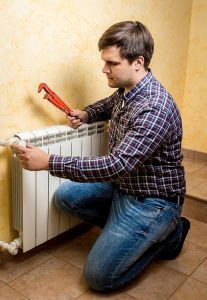 It’s only August, but that doesn’t mean we can’t be a little early to get you thinking about the cold season. After all, some stores are already putting out Halloween supplies!
It’s only August, but that doesn’t mean we can’t be a little early to get you thinking about the cold season. After all, some stores are already putting out Halloween supplies!
We want to give you plenty of time to think about three different kinds of upgrades or modifications you could make to your existing HVAC and plumbing system. Under the right conditions, they could be perfect for saving you big through the fall and winter.
Zone Control System
If you’re using a furnace and duct system to supply heating for your home, zone control could be a great solution for you.
With HVAC systems that use ducts, the one big problem is that you can only send air to the entire house. That means if you have unused rooms, you’ll have to use energy to send air to those rooms—there’s just no avoiding it. If you have kids who have just gone back to school after summer vacation, then you’ll know that their bedrooms are going to be unoccupied for another 6 months or so.
With zone control, you’ll get individual control over each room. Each room gets its own thermostat, which then programs a series of dampers in your ducts to redirect airflow. This will have an incredible effect on your energy bill since you’ll only be using energy on the rooms that matter.
Install a Boiler
If zone control doesn’t sound like it will be useful for your situation, but you like the idea of lowering energy costs, then maybe a boiler is just the thing for you.
It turns out, boilers are far more efficient than even the best furnaces. Boilers work by creating steam, moving it through pipes, and dispersing through radiators. On the other hand, furnaces must use ducts to transport that air. The problem with ducts is that they can develop leaks or tears, which will end up wasting energy.
They also have the benefit of being able to run on either gas, oil, electricity, or wood. It can be a little more expensive to install up front, but boilers provide a much more consistent heat source through the whole home.
Tankless Water Heater
Most homes are already equipped with a tank water heater—and for good reason. They’re fairly cheap and provide hot water for the home without much maintenance. However, it’s possible to take it for granted, preventing you from realizing that your water heater may be too big for your needs.
What we’re referring to is “standby heat loss,” and it’s a side effect of your water heater supplying more hot water than your home demands. This occurs when the hot water in the tank goes unused—the heat will eventually dissipate, thus causing the tank to fire itself up again.
This problem is solved with tankless water heaters, which you can think of as “on-demand” water heaters. As the name suggests, there’s no storage tank involved—the system uses electric resistance to heat the water when the hot water faucets are turned on. Any water heater installation expert in Maryland can help you replace your tank heater with a tankless heater.
